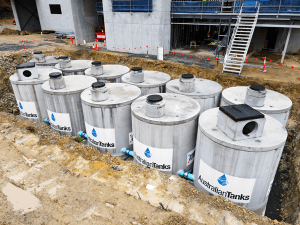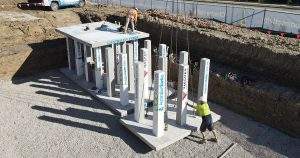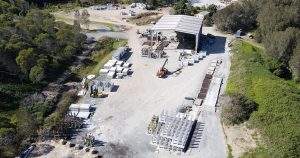Effective wastewater and stormwater management requires pumps, pipes and emergency storage. Here’s how these work together to protect the environment from runoff and sewerage.

To start with, you need to understand the difference between sewer and stormwater drainage.
- Sewer drainage – Sewer drainage is made up of underground pipes that take water and other matter that goes down the drain at a commercial or residential facility away to a treatment plant. After it is treated, the waste is usually released into waterways.
- Stormwater drainage – Stormwater drainage is made up of gutters and downpipes as well as other systems that direct stormwater into drains. Stormwater is generally not treated before making its way to larger waterways.
What is a pump station?
As we know, water can’t flow uphill, so a pumping station is needed to make sure wastewater gets to where it needs to go despite the topography of the land or the architecture of a building.
Most pumping stations work by collecting water in a tank. When the water reaches a certain level, a high-pressure pump sends the waste on its way. It’s a much more effective system than relying on gravity to do all the work.
Having operational pumping stations at your premises for sewerage and stormwater will prevent serious overflowing and leakage problems.

Sewer vs stormwater pump stations
Sewerage and stormwater pump stations are different because of the content of the fluid they are pumping.
A stormwater pump station is generally only used to pump water from a low point (basement) to the kerb or site outlet. It is designed to be empty, with its only purpose to pump water from the lowest point where water collected isn’t able to find the outlet via the fall on the property.
While stormwater pumping stations mostly have to deal with fresh water, sewage pumping stations have more noxious materials to contend with. For this reason, sewage piping stations have extra features and functionality, for safety and cleanliness.
The features you will find in a sewage pumping station that you won’t find in a stormwater pumping station are:
- Safety vent – Sewage pumping stations have safety vents to release gasses that might be building up. Without this, there is the risk that gas could cause an explosion or at least a rupture in the tank.
- Internal coating – Sewage pumping stations will also have an internal coating to protect the interior of the tank from corroding due to the noxious contents.
- Rinse – An optional extra for sewage pumping stations is a rinse that periodically sprays down the insides of the tank to keep it as clean as possible. While it is optional, it is recommended to include this feature if you are installing a new pumping station.
Both stations are similar, in that they stop wastewater from overflowing and causing unpleasant leaks or spills into the environment.
Pump station recommendations
Australian Tanks’ recommended pumping station is the 1500ID PIT. This model allows for THE FOLLOWING:
- Fluid velocities and turbulence to re-suspend sealed solids with every pump cycle, allowing them to be pumped away.
- Less sedimentation removal is required by suck trucks, providing savings in maintenance costs.
- Decreased sedimentation, which reduces septicity and odour issues.
- Decreased retention times of sewage and minimal ‘dead spots’ on the pump well base, to reduce accumulation and clumping of solids.
- Reduced pump blockages, to decrease maintenance call-out costs associated with pump blockages or float switches being fouled.
The 1500ID PIT includes:
- Anti-floatation design – The tanks will not float if they are submerged in water.
- 50 Mpa concrete – Very durable concrete that can withstand high pressure.
- Exposure classification – Rated with a B2 classification, in accordance with Australian Standards AS3735 (Concrete Structures for retaining liquids).
- Coatings – An external coating to protect from acidic soils.
- Extra heavy-duty design – Strong enough to withstand being run over by a heavy vehicle.
Sewer emergency storage explained
What is a sewer emergency?
A sewer emergency is pretty much exactly what it sounds like; a burst pipe or overflowing sewage tank that releases sewage where it is not supposed to be.
The issue can cause problems in the rest of the system, with toilets not flushing or sinks not draining.
As you can imagine, a sewer emergency is not something you want to deal with at a large block of apartments or a commercial building. It can cause severe damage, not to mention the unpleasantness of having raw sewage anywhere near where people live and work. With this in mind, it is smart to do everything you can to prevent it from happening.
Sewer emergency storage
Sewer emergency storage is used in conjunction with sewer pump stations.
In most cases, sewer emergency storages are added when it becomes apparent the original pumping station is not handling the load. Very simply, sewer emergency storage acts as more space to account for the volume of waste that the pumping station is not handling.
Sewer emergency storage is often installed to fix a problem after it occurs, rather than installed as a solution beforehand.
Do you need sewer emergency storage?
If you have a quality sewer pumping solution, odds are you won’t need a sewer emergency tank.
However, if you are anticipating a sudden and significant increase in your sewage output, you might consider calling in a consultant to look at adding a sewer emergency tank.
If you do need a sewer emergency tank, contact a professional to install it and ensure it is correctly connected to your original pumping station.
Choosing a sewer emergency storage from Australian Tanks
If you do need sewer emergency storage, Australian Tanks provides some of the best quality options in the country.
Our tanks feature:
- A unique modular solution, suitable for volumes ranging from 2,300 litres up to over 500,000 litres.
- Heavy duty traffic load rating up to unrestricted heavy vehicle access as per SM1600 traffic design loads in accordance with AS5100.2
- Installed underground, with the ability to support up to 1700mm of coverage, providing a broad scope of installation options
- Quick and easy installation – the tanks arrive on site ready to be installed so you can be ready in days not weeks with prefabricated tanks
- Easy maintenance
- Anti-floatation design
Choose Australian Tanks for reliable and long-lasting tanks that are easily maintained and will keep your sewage where it’s meant to be.
Pump stations and sewer emergency storage go hand in hand to protect the environment and ensure stormwater and sewerage do not end up where they are not supposed to.
For more information or for help designing your wastewater management solutions, contact Australian Tanks today.





